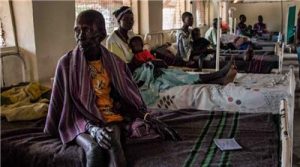Moral Dilemma:
In the case of “Ethics and Humanitarian Aid: Vertical Aid Programs”, Dr. Asadour works in a non-governmental organization (NGO) to help in a “global vertical aid anti-cholera program” (Thomas 267). Dr. Asadour and his team travel to South Sudan with a Memorandum of Understanding to treat cholera exclusively. Patients, with and without cholera, line up at the admissions tent. His moral dilemma arises when deciding who to admit into the hospital.
First, we need to understand the nature of the disease. Symptoms of cholera include watery diarrhea, vomiting, and dehydration. People can die within hours without treatment, so Dr. Asadour will need to act quickly. Also, according to the CDC, cholera “is not likely to spread directly from one person to another”. So long as his team is methodical in their actions with disposing wastes, Dr. Asadour should not worry about cross-contamination. (Center for Disease Control and Prevention)
Dr. Asadour’s moral dilemma involves the ethics of rationing. According to Beauchamp, rationing is “a form of allowance, share, or portion” and is linked to limited resources (Beauchamp 284). This means Dr. Asadour will need to exclude some people from these resources in order for other patients to receive full care. He must set priorities or guidelines as to who is and isn’t admitted to hospitals. Specifically, Dr. Asasdour must set criteria “to determine a qualifying pool of potential recipients” and decide the “final selection of recipients” (Beauchamp 288).
Dr. Asadour needs to assess the symptoms of the incoming patients to see if their symptoms match those of cholera. Although the work station has the supplies to treat other illnesses, the team has a legal obligation to treat patients with cholera only. They could send the extra supplies to the local hospital, but it not ethical to violate the original mandate. “If word gets out that the NGO will treat non-cholera conditions”, the work station will become overcrowded, lose supplies, and must shut down while those inflicted with cholera will remain untreated (Thomas 267).
As for treating patients with cholera, there are many types of rationing to consider. Rationing by age is the most straightforward policy because it includes numerical categories. There are still unethical issues to this method. For example, Dr. Asadour may deem it unethical to admit a seventeen-year-old boy with mild symptoms and refuse admission to middle-age woman with severe symptoms. The “first come, first serve” and the lottery methods are also unjustified in this case because symptom severity varies from person to person.
Dr. Asadour should consider a type of rationing that is involves a direct assessment of each individual patient and their symptoms related to cholera. He can assess each patient individually and personally. Dr. Asadour can use medical insight to determine the needs of each patient. Specifically, he interview the patients and collect information on the severity of their symptoms to determine who is admitted. There are some downfalls to this method. It will be time-consuming and qualitative, meaning Dr. Asadour will have difficulty comparing and ranking patients without numerical values.
Conclusion:
The best solution for Dr. Asadour is to stick to the original mandate of only treating patients with cholera because it is unethical and illegal to abandon the mandate. The NGO made the effort to send the team to South Sudan to treat cholera only, and it will be hazardous if the team abandons their original obligation to treat other diseases. They will risk losing supplies and the work station in its entirety.
Next, Dr. Asadour should assess each patient and determine the severity of their symptoms. Dr. Asadour will then make the decision of who to treat and ration the resources from person to person. Overall, there is no clear and fully ethical policy of rationing resources in vertical aid programs. However, all humanitarian aid workers must understand the joys and the consequences that can come with these programs. Due to scarce resources, workers will have to turn away some to treat others.
Beauchamp, Tom L., and James F. Childress. Principles of Biomedical Ethics. 7th ed. New York, NY: Oxford UP, 2001. Print.
Center for Disease Control and Prevention. “Cholera – Vibrio Cholerae Infection.” Centers for Disease Control and Prevention. Centers for Disease Control and Prevention, 03 Oct. 2014. Web. 12 Apr. 2017.
Thomas, John E., Wilfrid J. Waluchow, and Elisabeth Gedge. “Case 8.2: “Ethics and Humanitarian Aid: Vertical Aid Programs.” Well and Good: a Case Study Approach to Health Care Ethics. 4th ed. Canada: Broadview, 2014. 131-138. Print.


Hi Sylvie,
I agree that the best plan of action for Dr. Asadour is to treat each patient based on a thorough examination and to only treat those seeking relief from cholera. When it comes to practically implementing this system though, time is a limited resource. People can die within hours without treatment so in the time it takes to thoroughly examine one patient, another patient with a more severe case could die. If he is able to allocate several assistants or versed volunteers to help conduct preliminary assessments of each patient to determine whether or not they have choleric symptoms and the severity, more patients would benefit in the end. If Dr. Asadour doesn’t have extra support, it would be better to implement a quantitative system that is more structured and less personal in order to quickly identify high-need patients. Also, it’s best that patients are admitted on the basis of how life-threatening their condition is so that resources can be distributed accordingly and maximum utility can be executed. It’s unfortunate that some patients will be turned away considering the NGO has extra supplies but it’s possible that some cholera patients may have additional complications where those supplies would be helpful and that way the clinic is prepared for the unknown.
Hi Sylvie! I enjoyed reading your post and I agree with you that 1) the clinic should only focus on cholera patients and 2) Dr. Asadour should treat patients in order of severity. It is unfortunate if other patients come to the clinic seeking care, but I agree that if this clinic is meant to be for cholera and assuming cholera is the most pressing health crisis in the area, then the clinic should focus its resources on alleviating that disease. As you suggested, perhaps they can donate other resources not needed for cholera treatment to a local clinic or use them to help others after hours if the doctors are willing.
I currently volunteer at the Emory Hospital in the ER and like most emergency departments, they treat patients in order of severity rather than on a first-come first-serve basis. While this causes much frustration for patients who have been waiting for hours, it is the most efficient method we currently have to ensure that those who are at a higher risk of severe complications or even death are given the treatment they need as soon as possible with limited resources.
I often wonder if there are ways we can improve the system. I agree with chenri3 above that it would be helpful if Dr. Asadour had the support of volunteers for an initial evaluation. In my experience, the most frustration comes from those who have been waiting with little to no perceived attention to their issue. If you are in the ER waiting room, you often see your own ailment as the most urgent issue in your life even though it may not be as life-threatening as the condition of someone next to you. To apply it to this case, perhaps Dr. Asadour could create an initial screening process that acknowledges the patient’s needs and ensures that they feel valued even if they are not on the top of the urgency list. Regular check-ups and updates to those in the waiting room are simple measures to decrease patient frustration.
According to the WHO, cholera is easily treated. The issue is access to resources as well as time. For these patients, doctors are racing against the clock. Most patients can be treated simply by the administration of an oral rehydration solution. This can either be given orally or through a nasogastric tube. If the resources allow, it would be ideal to start every patient with symptoms of cholera on a baseline dose of this solution before further evaluation. Doctors could ration the amounts so that everyone gets the same amount initially which is then increased based on the severity of the individual case. For some patients with minor symptoms, doses below the therapeutic level could be administered to 1) prevent the disease from escalating and 2) give the patient the attention they crave (which might even create a placebo effect). It may sound like an odd solution, but again, much of the frustration in emergency situations comes from mental perceptions in addition to physical pain. Then, for the severely dehydrated patients, IV administration and antibiotics can be administered as need be, as suggested by the WHO.
Luckily for a clinic that is solely focused on one condition, it should be relatively simple to treat patient’s once their severity is determined. Since almost all of the patients will be treated with the same measures, the clinic could operate as a “treatment assembly line”. The only limit then is resources. This begs the question of the length of treatment. For example, is it better to give one patient full treatment so they walk away with a cure even though some people never get treatment? Or is it better to give all patients a little treatment but no one really walks away cholera-free? These are tricky issues and I look forward to hearing your thoughts!
WHO. (2017). Cholera Fact Sheet. World Health Organization. Retrieved fromhttp://www.who.int/mediacentre/factsheets/fs107/en/